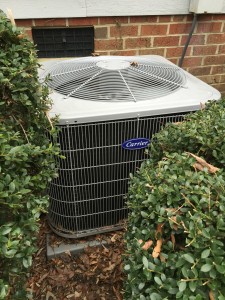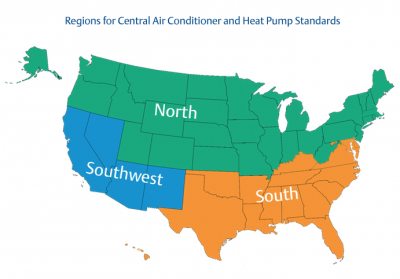 New federal HVAC regulations 2015 went into effect January 1, 2015, and there’s a lot you need to know! Over the past decade, the Department of Energy (DOE) has implemented new regulations that are designed to improve energy efficiency, lower emissions of greenhouse gases, and reduce our dependency on fossil fuels. But the new federal HVAC regulations 2015 are a big deal! For the first time, the DOE is implementing minimum federal efficiency standards – by region. The new rules have big changes for SEER ratings (Seasonal Energy Efficiency Ratio).
New federal HVAC regulations 2015 went into effect January 1, 2015, and there’s a lot you need to know! Over the past decade, the Department of Energy (DOE) has implemented new regulations that are designed to improve energy efficiency, lower emissions of greenhouse gases, and reduce our dependency on fossil fuels. But the new federal HVAC regulations 2015 are a big deal! For the first time, the DOE is implementing minimum federal efficiency standards – by region. The new rules have big changes for SEER ratings (Seasonal Energy Efficiency Ratio).
New Federal HVAC Regulations 2015 – The Regions
The new regulations break up the United States into 3 regions: the South, the Southwest and the North. The new regulations affect the regions differently, and it’s important to know the impact in your region. The region most impacted by the new regulations is the South, which includes AL, AR, DE, FL, GA, HI, KY, LA, MD, MS, NC, OK, SC, TN, TX, VA, and DC.
The Southwest region consists of: AZ, CA, NV, and NM
The North region includes: AK, CO, CT, ID, IL, IN, IA, KS, ME, MA, MI, MN, MS, MT, NE, NH, NJ, NY, ND, OH, OR, PA, RI, SD, UT, VT, WA, WV, WI, AND WY.
New Federal HVAC Regulations 2015 – What’s Changing?
Effective January 2015, ALL heat pumps installed (including split system heat pumps) will have to have a 14 SEER rating (regardless of region). Heat pumps will also be required to have an 8.2 Heating Seasonal Performance Factor (HSPF).
Air conditioners, packaged air conditioners and gas packs installed after this date in the South and Southwest regions are required to have a 14 SEER rating, but there is an 18-month grace period. The grace period allows for the installation of an air conditioner that was manufactured before January 1, 2015, and allows manufacturers and distributors to reduce their inventory of 13 SEER units and begin to phase them out. The grace period expires on July 1, 2016.
Air conditioners and gas packs in the North region will still be allowed to have a 13 SEER rating, but heat pumps in the North will have to be 14 SEER. So… the new air conditioner that you install in Colorado might be out of compliance in North Carolina!
New Federal HVAC Regulations 2015 – How This Will Impact YOU!
While these new regulations come with the best of intentions, they may have a big impact on homeowners. Both indoor and outdoor units must be compatible, which could result in increased costs for the homeowner. For example, according to some HVAC professionals, if all you need is a new evaporator coil, you may have to replace your whole system. Homeowners could also be forced to make structural changes or additions to their home in order to accommodate new 14 SEER systems.
It’s more important than ever to hire a reputable HVAC contractor who is familiar with the new regulations. Your contractor will need to verify that any new equipment installed meets 2015 standards. How this is going to be enforced is unclear. But what is clear, is that you should work with a reputable contractor who knows and understands the rules in your region.
Purchasing a new air conditioning system, heat pump or furnace is a big deal, and can cost a pretty penny. The higher the energy efficiency, the higher the cost of the unit. But savings will accrue to you in decreased energy costs. The DOE estimates that the new rules will result in $63 billion in consumer energy savings through 2044. Also, DOE predicts that the changes will avoid 172.5 metric tons of carbon monoxide emissions, which is the equivalent to the ANNUAL greenhouse effect of 33.8 million cars!
And FYI, there will be NEW water heater energy requirements, effective 4/16/2015! DOE will require higher energy factor ratings on most residential gas, electric, oil and tankless water heaters. The new water heater regulations will affect homeowners differently, based on fuel type and space in the home. The regs will target water heaters larger than 55 gallons.
So be smart about your energy choices, and make sure your HVAC contractor and/or plumber understands the new federal HVAC regulations 2015!
*Map courtesy of Emerson Climate Technologies

